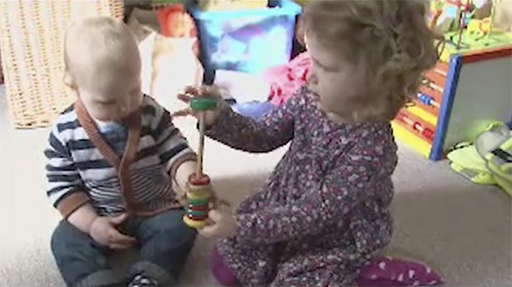1 Observing, planning and recording
In order to make informed decisions about the opportunities and experiences practitioners provide for the babies and toddlers they work with, they need to get to know them and build a picture of their interests, skills and motivations. To do this, they start by observing them – but what does that really mean?
Activity 37.1 Activity 1 Words and meanings
Take a moment to think about the words below and consider if you think they have different meanings:
- Watching
- Looking
- Noticing
- Seeing
- Observing
Comment
It is difficult to highlight any clear or specific differences between these words – they all overlap. It can be useful to think as ‘observation’ as an umbrella term that covers all the different approaches practitioners use to find out more about the babies and toddlers they work with. Doing this helps them to make sure they are using as many different types of observation as possible in order to get the clearest picture.
Trying to keep track of what we see babies and young children doing can be tricky, because there are often lots of things happening at the same time.
Activity 37.2 Activity 2 Observing an activity
Watch this video of children playing together in a nursery and note down what you see.

Transcript: Video 1
Discussion
As you watched the video you might have focused on the language the children used, or the physical skills that they showed as they played. Perhaps you noticed the involvement of the adult, or the different social and emotional responses the children demonstrated. It is almost impossible to capture everying that a child is doing in a situation, so when we undertake observations it can be helpful to have a clear idea of what we are focusing on before we start.
To be able to focus on a specific area of development or learning, you need to think about what your role in the observation is. Are you part of the action or are you watching from afar? Does the child know that you are looking at what they are doing or not? Take a look at the descriptions of the role of the observer in the box below.
| Overt | The child knows they are being observed. |
| Covert | The child is not aware that they are being observed. You might think that this would not apply to babies, but if you remember what was discussed in Week 1 about babies being aware of the adults around them and the communication techniques they use to engage them, this shows that babies know when they are being observed. |
| Participant | The observer is taking part in the activity while undertaking the observation. |
| Non-participant | The observer is not part of the activity that is being observed. |
These elements can be combined. For example, if you were sat on the other side of the baby room watching a child using a Treasure Basket, that would be a covert, non-participant observation. If you were on the floor using a toy to encourage a baby to roll over, that would be an overt, participant observation.
ITQ 37.1
-
What effect do you think these different approaches can have on what we see?
-
If a child knows they are being watched they are more likely to change their behaviour, in the same way that we do as adults. Have you ever been in a coffee shop or on a bus and realised that someone is looking at you? A soon as you get that sensation you become more aware of what you are doing or how you are moving, and that is the same for babies and toddlers.
Undertaking an observation when you are part of the activity can make it difficult to capture what you have seen. It is not always possible to stop what you’re doing and make a note, so you have to remember what happened – and in a busy baby room that can be difficult.
Now that you have thought about what your role in observation is, you can then consider what you want the observation to focus on. Different types of observation will provide different types of information.

